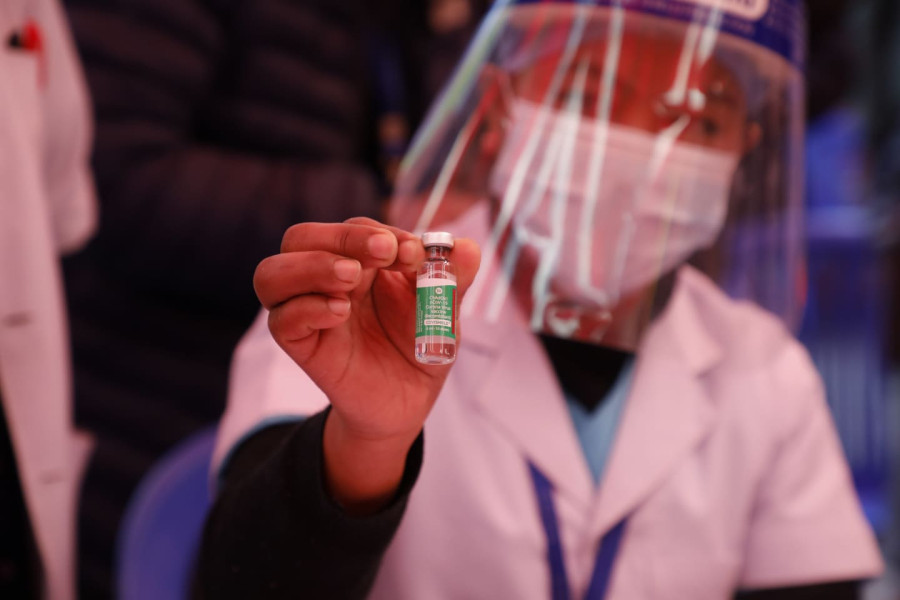Health
Interval between Covishield vaccine doses likely to be eight to 12 weeks
Officials had earlier said second dose will be administered four weeks after the first one. But fresh recommendations from WHO suggest otherwise, giving rise to dropout fears.
Arjun Poudel
Those who received the first dose of AstraZeneca’s Covid-19 vaccine (Covishiled) in Nepal in the last few weeks are likely to get their second jab only after 8 to 12 weeks—at least four weeks behind the pre-planned schedule.
Officials are considering making the change following recommendations from the World Health Organization’s Strategic Advisory Group of Experts on Immunization on Wednesday to maintain an interval of 8 to 12 weeks between the first and second jabs of the vaccine developed by the University of Oxford and pharmaceutical giant AstraZeneca.
"We will hold a meeting of stakeholders and take a call as per recommendations from the World Health Organization," Dr Shyam Raj Upreti, coordinator of the Covid-19 vaccine advisory committee, told the Post. "By following the UN health agency’s recommendations, we can inoculate more people from the existing stock of vaccines."
Earlier, the Ministry of Health and Population had decided to keep an interval of four weeks between the first and second doses of the vaccine.
According to Upreti, the WHO has also said that the Oxford-AstraZeneca vaccine can be given to all adults above 18, including pregnant women and nursing mothers if they are in normal health.
"From now on, we will also provide the jabs to pregnant women and nursing mothers on the priority list," added Upreti.
Due to safety concerns, pregnant women and nursing mothers, who were on the priority list prepared by the Health Ministry, had not been inoculated.
The government rolled out its coronavirus vaccination drive on January 27 using the one million doses of the Serum Institute of India-produced Covishield vaccine provided by India under grant assistance.
Front line workers—health workers, supporting staff at the health facilities, female community health volunteers, ambulance drivers, security personnel deployed for management of bodies of the dead—as well as senior citizens living in old age homes, and prisoners, were on the priority list for the first phase campaign.
The ministry had planned to inoculate 430,000 people in the first phase, but only 184,857 in the target group received the jab in the first 11 days of the campaign.
The ministry has been inoculating staffers serving at various diplomatic missions and journalists using the vaccine stock. It now plans to inoculate service providers who come in frequent contact with the public in sectors such as banking, revenue collection, electricity and water supply, telecoms, transportation, and others from Sunday.
The government still has around 800,000 doses of Covishield in stock.
“We are discussing the extension of the interval between the first and second doses of the vaccine,” Dr Jageshwor Gautam, spokesperson for the Health Ministry, told the Post. “We will decide after an expert panel makes recommendations.”
Gautam said that the ministry can use all remaining doses to give people their first jabs if there’s a guarantee that additional doses of Covishield can be procured on time for the second jabs. A person needs two doses of vaccine and the same vaccine (Covishield) is used in the doses.
“We won’t use the stock without ensuring the supply of the second dose,” added Gautam.
Public health experts are worried that poor record-keeping, inadequate vaccine storage capacity, and possible dropouts could hamper the campaign if the interval between the two doses is increased.
“We must review our record-keeping system, assess our capacity to store the vaccine, and consider the dropout rate while extending the intervals between two doses,” Dr Sarad Onta, a public health expert, told the Post.
According to Onta, a lot of people could miss the jabs, if the record-keeping system is not effective. Authorities have to procure a large number of doses of vaccine at once if a large number of people are to be inoculated at once and the existing storage capacity of the country is not sufficient.
“We are inoculating a large number of adult people for the first time in the country,” said Onta. “I fear the vaccine drop rate will be high if the interval between the first and second dose is long.”
Doctors also questioned the capacity of the government to inoculate a large population at once. “Despite having sufficient doses for certain target groups, we could not inoculate all health workers by taking them into confidence,” Dr Baburam Maraasini, former director at the Epidemiology and Disease Control Division, told the Post. “Authorities concerned should seriously review this failure and make further plans accordingly.”




 12.12°C Kathmandu
12.12°C Kathmandu














